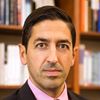The mass shooting Thursday at Umpqua Community College in Oregon is heartbreaking--especially for the students and families directly affected. But it is tragic in a different way for those of us in public health who have followed the trajectory of gun violence in the U.S. and tried to sound a call for change.
Firearm deaths are a preventable epidemic.
There is no other cause of death that we know how to prevent so readily--and that, time and time again, we do nothing about.
And so we wake up today to the latest of more than 40 school shootings this year--the headlines so familiar to us, even as the geography and the faces of grief change.
The extraordinary prevalence of firearm-related violence in the U.S. stands in harsh contrast to our peer nations. There have been 142 school shootings in the U.S. since the December 2012 massacre at Sandy Hook Elementary School in Newtown, Connecticut. In 2003, the U.S. had the highest rate of firearm homicide (6.9 times higher than others) and firearm suicide (5.8 times higher) among 23 populous high-income nations.
The U.S. clearly has a long and complicated relationship with firearms, and, constitutional rights aside, there are abundant organizations and high-profile arguments on the side of unfettered firearm availability. But while the arguments around the rights to gun ownership often center around self-protection from other firearms, the evidence is overwhelmingly clear that this claim is not supported by data.
Studies on the risks of firearm availability on mortality have provided strong evidence of an increased risk of both homicide and suicide. A recent meta-analysis of 16 observational studies, conducted mostly in the U.S., estimated that firearm accessibility was associated with an odds ratio of 3.24 for suicide and 2.0 for homicide, with women at particularly high risk of homicide victimization. In the case of firearm suicide, adolescents appear to be at particularly high risk, relative to adults.
A 2013 study led by Boston University School of Public Health researcher Michael Siegel found that U.S. states with higher estimated rates of gun ownership experienced a higher number of firearms-related homicides. Another recent study examining the association between firearm legislation and U.S. firearm deaths by state between 2007 and 2010 found that stronger legislative restrictions were associated with lower gun mortality.
But despite the clear evidence that guns pose a threat to health, the public health community has been unable to get traction as an effective voice on this issue. Unfortunately, instead of quality scholarship and policy efforts to map and respond to the risks of guns, we have seen the silencing of gun researchers, health practitioners, and policymakers intent on addressing these problems.
Actions by Congress, fueled by the National Rifle Association (NRA) in 1996, effectively defunded federal gun research, a still extant legacy, and to date, the CDC website lacks materials on prevention of gun-related injury or violence. While translatable lessons from successful public health campaigns on smoking, unintentional poisonings, and car safety abound, the political will necessary to implement and test them has been absent and under unremitting attack.
Would we tolerate such lapses in our response to other prevalent health challenges? Imagine for a moment that, because of emphatically articulated rights-based arguments, the U.S. remained alone among peer countries in not having seatbelt laws, and that our automobile death rate was seven-fold greater than that of Canada. Would that be tolerable?
While acknowledging the broader issues around the balance of rights and privileges, it seems to me that it falls to public health to be a clear voice against the legal widespread availability of a pathogen--guns--that other peer nations have long ago conquered.
In many ways, I worry that the voice of academic public health has been far too quiet on this issue, simply because the typical mechanisms that support our scholarship--extramural funding chief among them--have not been conducive of this work. But it is on us to organize our efforts in a way that will allow us to be a compelling voice on the issue--by translating scholarship and joining the public conversation around this issue.
The ultimate solution to the firearm epidemic does not lie with the doctors who treat victims, or with the community providers who try to keep youths away from guns. It lies rather with policymakers and legislators. An activist public health community needs to play a central role in engaging this constituency through data-driven research and scholarship.
It is only then that we have any hope of turning the tide on what is truly a preventable epidemic.
